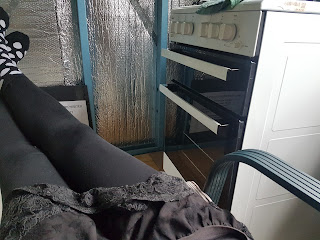2021 November
Ok let's go back in the time machine - and remember when the plumber Steve came out for a day of work from Lismore and installed our plumbing rough-in. The photo below shows the kitchen - on the left is the gas pipe coming up ready to join to the gas stove, and on the right is the hot and cold water pipes coming up ready to join the kitchen sink. They are all copper pipes, and the green side is the hot water which is covered with a plastic layer which helps keep in insulated , the heat stays in while it travels from the hot water system.
The below photo shows the bathroom. On the left is the hot and cold pipes for the laundry tub, and hot and cold pipes for the washing machine. In the middle is the hot and cold pipes for the bathroom basin. On the right is the hot and cold pipes for the shower/bath. You can see they come in to the middle to a central mixer, then one goes up for the shower head and one goes down for the bath tap.
The below photo shows the copper pipes which run under the house. Sorry it's at such a crazy angle but it turns out it's really hard to take photos while lying under the house! You can see the green covered pipes from the hot water, and the copper pipes for the cold water and the gas.
We also got a tap put on the outside of the house, to attach a hose onto. Great for watering the garden!
An electric water pump was placed under the house, connecting the water from the stainless steel tank to all of these copper pipes. This pump is connected to the solar power. It was placed on a concrete slab that the plumber brought with him, put on top of a bed of gravel. The gravel was stuff we had left-over from the truckload we had delivered for the tank stand.
Below is the instant gas hot water system. We had to specify to the plumber that we needed an off-grid system, as he had only previously installed on-grid systems which need to be plugged into electricity to work. This one has a clever design with an inbuilt hydro-electric generator that lights the gas as soon as the hot water tap is turned on. Amazing! This saved us from having to get a special outdoor power point installed just for operating the gas hot water system. This hot water runs to the kitchen sink, bathroom basin, bathroom shower-bath combo, laundry tub and washing machine.
In the below photo you can see the two large gas bottles which have been installed, connected to the copper pipes for the gas. These bottles supply gas to both the gas hot water system and to the gas stove. They were placed onto pre-made concrete slabs which the plumber brought with him, settled onto a gravel base. The gas bottles were delivered by the local rural supply store at Tabulam. Thanks Mark!
In the below photo you see the gas stove connected to the gas, in the spot where it will live when the kitchen is finished. You can't see it in the pic as it's behind that cardboard, but there is also a drain outlet for the kitchen sink in the floor.
Below you can see the washing machine which is temporarily hooked up to the water inlet, which is behind it where you can't see. Also behind it is the outlet pipe which the waste water goes into, then into a drain pipe which takes the water away from the house. We can wash laundry plugged into the solar power when it's a nice sunny day no problem, don't have to run the generator for that anymore!
On the right side of the pic you can see the drain outlet which will be used for the basin drain in the future. At this point the drain outlet for the bath/shower was not placed, as we needed to know exactly which bath we were getting before it could be put precisely in the right place. You can't quite see it in this pic but there is also a floor drain placed right in the middle of the floor.
We did have a bit of problem for a while when the antechinus figured that it could climb up into the house by scampering up this drain hose, but we fixed it by shoving some aluminium mesh into the hole and that managed to keep it out. Naughty creatures!

I can't remember exactly but I think the plumber cost around $4000, and the gas bottles were about $250 delivered.


















































